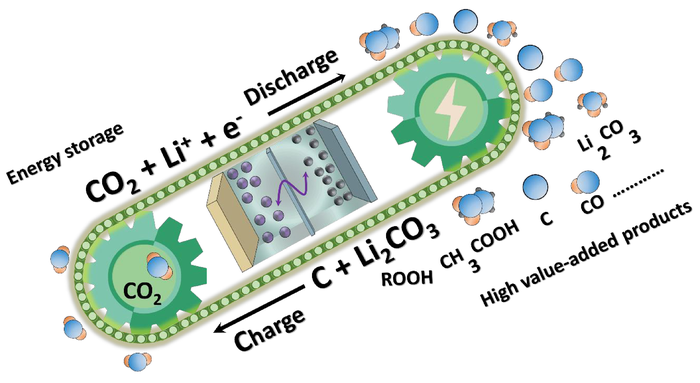Reviewed by Alex SmithApr 11 2022
The lithium-carbon dioxide battery is considered a new type of energy storage and conversion device. Despite the fact that the advancement of these batteries is still in its early stages, researchers must already have a detailed understanding of the critical issues that must be overcome for these batteries to reach their full potential as novel energy storage devices.
 Schematic illustration of the concept of Li-CO2 batteries toward high efficient energy storage and CO2 fixation. Image Credit: Nano Research Energy.
Schematic illustration of the concept of Li-CO2 batteries toward high efficient energy storage and CO2 fixation. Image Credit: Nano Research Energy.
The study of lithium-CO2 batteries was undertaken by an interdisciplinary research team to fully comprehend the problems and prospects of these devices.
The group, headed by scientists from Australia’s University of Adelaide, published their findings on March 21st, 2022, in the journal Nano Research Energy.
Investigators directed their focus to carbon capture and storage since carbon dioxide plays an important role in global temperature cycles. Lithium-CO2 batteries are an interesting option for converting waste carbon dioxide into value-added products as well as storing electricity generated by renewable energy sources.
Lithium-CO2 batteries are much more compelling than other metal-CO2 batteries, like zinc-CO2 and sodium-CO2 batteries, not only in terms of providing the highest operating voltage and energy density but also in terms of potential use in aviation and aerospace industries, where lightweight materials are highly desirable. While lithium-CO2 batteries have great potential, they also have a lot of challenges because of carbon dioxide.
The group brought together experts from different fields to approach the problems from a multidisciplinary perspective. They set out to investigate the issues that critical components of the battery, such as the interface, electrode, and electrolyte, face.
The group also made recommendations for how to deal with these issues. Their goal is to lay the groundwork for more research into reversible and rechargeable alkali metal-based carbon dioxide battery systems.
Specifically, we have figured out that the basic understanding of the electrochemical mechanism is still controversial, the performance at a high rate is still far from satisfactory for practical application due to the lack of efficient electrocatalysts.
Zaiping Guo, Professor, School of Chemical Engineering and Advanced Materials, The University of Adelaide
The observations can help other scientists and stakeholders to better comprehend these batteries and to place their research in a feasible context.
Despite the challenges, we have to say that, with continuous efforts, practical Li-CO2 batteries with highly efficient CO2 fixation and high energy storage are achievable.
Zaiping Guo, Professor, School of Chemical Engineering and Advanced Materials, The University of Adelaide
The researchers hope that their analysis of the prospects and challenges for lithium-carbon dioxide batteries will spark new ideas about batteries and catalysis, as well as provide the guidelines necessary for researchers to improve other important metal-gas energy storage devices.
In terms of future research, the team will look into ideas for a more efficient catalyst.
The main concern for a lithium-carbon dioxide battery lies in the slow kinetics of the electrode reactions, so the next step in the development of lithium-carbon dioxide is to seek an efficient catalyst that can boost the electrode reactions during battery charge and discharge.
Zaiping Guo, Professor, School of Chemical Engineering and Advanced Materials, The University of Adelaide
The team sees long-term potential in more extreme environments, in addition to applications for the batteries here on Earth. The use of CO2 as a cathode material enables the energy system to provide significant advantages in aerospace exploration, such as on Mars, where the atmosphere contains up to 96% CO2.
“There is no doubt that there is a long way to go, and more investigation and a better fundamental understanding of high energy density Li-CO2 batteries require multidisciplinary and cross-field research, ranging from chemical engineering to material science, electrochemistry, and nanotechnology,” concludes Guo.
Scientists from the University of Adelaide’s School of Chemical Engineering and Advanced Materials, as well as the University of Wollongong’s Institute for Superconducting and Electronic Materials, are part of the team. The research was funded by the Australian Research Council.
Journal Reference:
Zhang, S., et al., (2022) Challenges and Prospects of Lithium−CO2 Batteries. Nano Research Energy. doi.org/10.26599/NRE.2022.9120001.